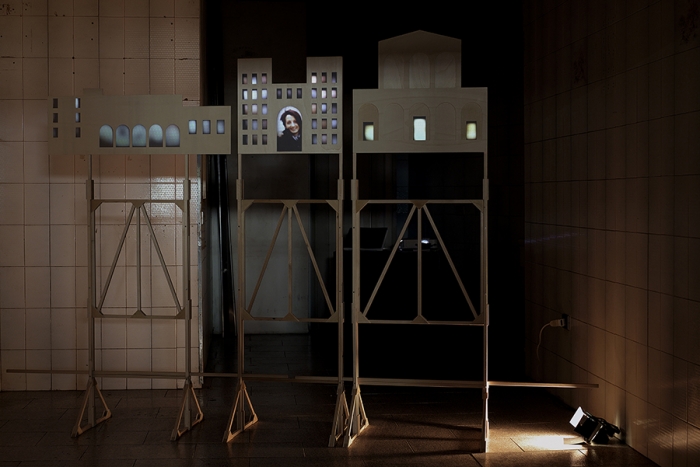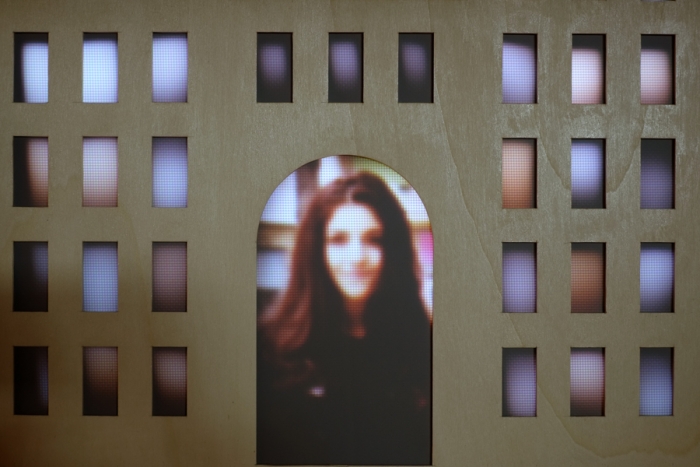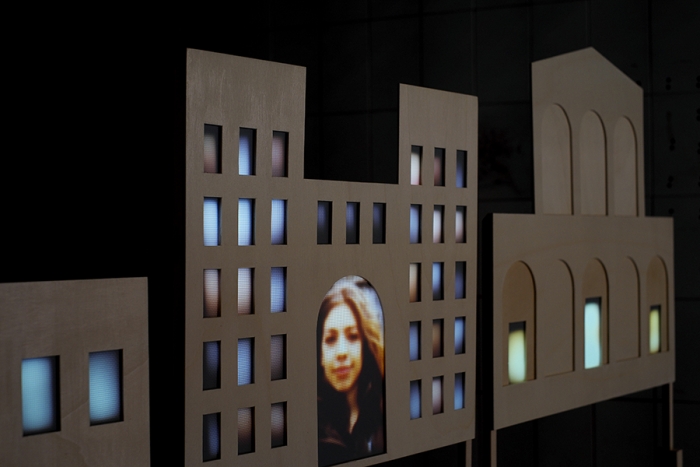HABITAT
2014
wood, pvc, videoprojector.
variabile size

La ricerca artistica di Daniele Spanò si sviluppa lungo due linee guida principali: la riflessione sullo spazio – dalla quale emerge la sua formazione di scenografo – e quella sul tempo, portata avanti attraverso l’utilizzo del video e, in particolare, della tecnica del mapping. Due percorsi che trovano spesso sintesi formale in videoinstallazioni la cui superficie di proiezione diventa soglia per riflettere sul rapporto tra l’individuo e lo spazio che lo circonda: da quello pubblico e sociale, fino ad arrivare a quello più intimo e privato. Il Palazzo dei Ferrovieri (più noto come “Palazzo dei Cervi”, o “dei Daini”), sorto sul finire degli anni Venti in piazza Tommaso de Cristoforis; la Scuola Elementare “Giovanni Randaccio”, completata all’inizio degli anni Cinquanta nella medesima piazza; infine, la Chiesa di Santa Maria Consolatrice, costruita nell’omonima piazza tra il 1942 e il 1945. Si tratta di tre degli edifici principali di Casal Bertone che – dal secondo dopoguerra in poi – hanno raccontato parte delle vicende di un intero quartiere.
L’artista riproduce questi edifici in una scansione sequenziale lignea, che formalmente ricorda, a tratti, una quinta prospettica rinascimentale, e, più idealmente, a un’agorà contemporanea; una sintesi di tre punti di riferimento e aggregazione chiave – la chiesa, la scuola, il condominio – comuni a numerose periferie romane nate intorno agli anni Cinquanta e Sessanta del Novecento. Daniele Spanò ha esplorato il quartiere fermando i suoi abitanti e invitando chiunque volesse a posare per circa un minuto davanti alla videocamera, lasciando emergere un ritratto collettivo di Casal Bertone, habitat complesso e stratificato. Un ri-trarre che fa appello alle molteplici radici del suo significato (“rappresentare, trarre fuori”, ma anche “tirare indietro, allontanare”): un dialogo sospeso tra curiosità e diffidenza, tra identità soggettiva e immagine pubblica, in un’alternanza tra soglie spaziali ed emotive ora indefinite, ora messe a fuoco (come il varco centrale dell’opera), aperte verso l’osservazione e la percezione dell’altro.
Valentina Fiore
Daniele Spanò’s artistic research develops according to two main guidelines: his concept of space, from which his work as a set designer evolved, and time, developed through video and, in particular, video mapping.
Two paths that often find symmetry in his video installations on which the surface for projection becomes a threshold into the relationship between an individual and the space that surrounds him. The Palazzo dei Ferrovieri (better known as Palazzo dei Cervi, or dei Daini [deer]), built at the end of the 1920s in piazza Tommaso de Cristoforis; the Giovanni Randaccio elementary school, built at the end of the 1950s in the square with the same name; and the Church of Santa Maria Consolatrice, constructed between 1942 and 1945. These are the three main buildings in Casal Bertone that tell part of the history of an entire neighborhood from the Second World War.
The artist reproduces these buildings in a linear sequential scan that recalls, in places, the perspective of a Renaissance stage set, and, more ideally, a modern agora; a synthesis of three key points of reference and meeting places – church, school, condominium – very common in the outskirts of Rome that were built in the nineteen fifties and sixties. Daniele Spanò explored the neighborhood, stopping its inhabitants on the street and inviting people to pose for about a minute for the camera thereby creating a collective portrait of Casal Bertone, a complex and stratified housing development. The images are defined by the Italian word for represent, “ri-trarre”, and appeal to the multiple origins the word (“represent, present” as well as “pull back, remove). A dialogue suspended somewhere between curiosity and distrust, subjective identity and public image, that alternates between thresholds into spaces and into emotions, at times blurry and at times in focus (like the central passage in the work), and open onto the observations and perceptions of others.
Valentina Fiore

